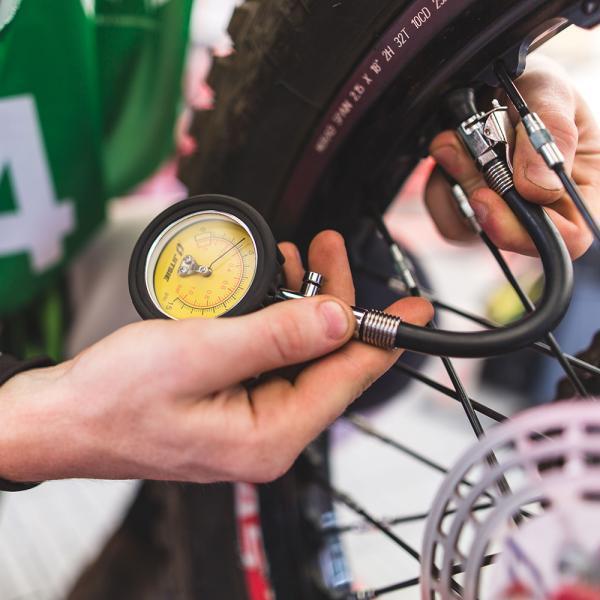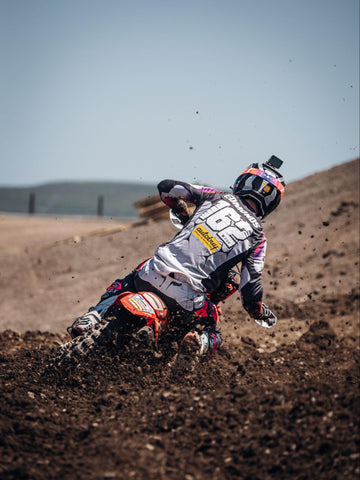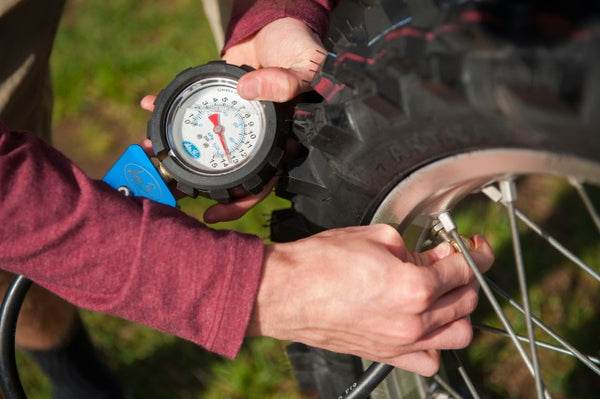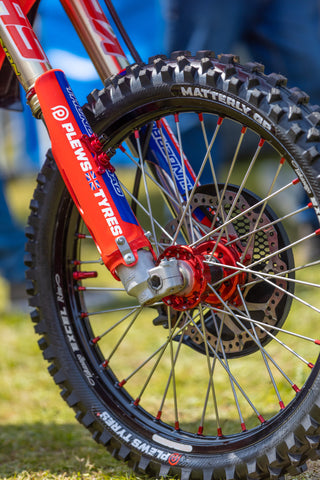Votre panier est vide
Des produits
shop your way
MOTO TIRES
Équipement d'équitation
How to Prevent Your Dirt Bike Tires from Going Flat
mai 02, 2024

Picture this: you're out on the trail or at the track, the wind whipping past you as you navigate the rugged terrain on your trusty dirt bike. Suddenly, your ride comes to a jolting halt – a flat tire. It's every rider's nightmare, but fear not, because we've got the tips and tricks to keep your dirt bike tires inflated and your adventure rolling.
To keep your dirt bike tires from going flat, proper tire maintenance is key. Regularly check your tire pressure and inflate them to the recommended levels. Additionally, inspect your tires for any signs of damage, such as punctures or cuts, and replace them as needed.
But wait, there's more to keeping your dirt bike tires in top shape than just maintaining pressure and checking for damage. Let's dive deeper into the world of tire care and explore additional strategies to ensure a smooth and puncture-free ride.

Proper Tire Maintenance:
What are the best practices for dirt bike tire care?
Ensuring the proper care of your dirt bike tires is paramount to maintaining peak performance and safety on the trail or track. Embracing a comprehensive approach to tire care involves more than just routine maintenance; it requires a commitment to adopting best practices that safeguard your investment and enhance your riding experience.
First and foremost, prioritize regular cleaning to rid your tires of accumulated dirt, mud, and debris. By keeping your tires free from obstructions, you not only maintain their appearance but also mitigate the risk of punctures and abrasions during your rides. Make it a habit to inspect your tires after each outing, paying close attention to the tread and sidewalls for any signs of wear or damage.
Moreover, proper storage techniques play a pivotal role in preserving tire integrity over time. Elevate your bike when not in use to prevent flat spots from forming on the tires. Store your bike in a cool, dry environment away from direct sunlight and harsh weather conditions, as prolonged exposure can accelerate tire degradation.
Are there any specific routines for maintaining dirt bike tires?
Establishing specific maintenance routines is key to preserving the condition of your dirt bike tires. These routines may include regular cleaning after rides, tire pressure checks each outing, and thorough inspections. By incorporating these routines into your schedule, you can proactively address any issues and extend the lifespan of your tires.
How often should I maintain my dirt bike tires?
The frequency of tire maintenance depends on various factors such as riding frequency, terrain, and weather conditions. As a general guideline, aim to inspect your tires before each ride and perform more comprehensive maintenance tasks, like cleaning and pressure checks, on a weekly basis. Adjust this frequency as needed based on your riding habits and environmental factors.
To make tire maintenance tasks easier, consider using a dirt bike stand like the ATS Adjustable Top Magnetic Motocross Stand available at Risk Racing. This stand provides a convenient and stable platform for elevating both tires off the ground, facilitating cleaning, inspections, and other maintenance tasks with ease. You can find this product at the following URL: ATS Adjustable Top Magnetic Motocross Stand.
Tire Pressure:
What is the recommended tire pressure for dirt bike tires?
Determining the ideal tire pressure for your dirt bike tires is crucial for achieving optimal performance and safety, and it's a factor that can vary significantly depending on various factors, including rider weight, bike model, and the terrain you'll be riding on.
Enduro Riding:
For Enduro riders, who tackle a mix of off-road terrain ranging from rocky trails to muddy tracks, finding the right tire pressure is essential for balancing traction, stability, and maneuverability. Bibs have become the most popular way to set up tires for enduro riding. It’s simply a foam insert that goes into the tire in place of an air-filled tube, riders will drill holes or shave the bib to adjust the perceived “air pressure” feel of the tire. However tubes are still a good option, in general, Enduro bikes tend to benefit from slightly lower tire pressures compared to motocross bikes, as this allows for better grip and compliance over rough terrain.
When riding Enduro, consider starting with a lower tire pressure range, typically between 8 to 12 PSI (pounds per square inch) for the rear tire and 9 to 13 PSI for the front tire. However, it's crucial to experiment with different pressures based on the specific conditions you encounter during your rides. Adjusting tire pressure can help you fine-tune your bike's handling characteristics and maximize traction on different surfaces.
Motocross Riding:
Motocross riders, who primarily navigate groomed tracks featuring jumps, berms, and hard-packed soil, often prefer slightly higher tire pressures to maintain responsiveness and prevent pinch flats. The optimal tire pressure range for motocross bikes typically falls between 12 to 15 PSI for both front and rear tires.
Higher tire pressures provide better stability and responsiveness during aggressive cornering and jumps, allowing riders to maintain control and minimize the risk of tire damage on hard landings. However, it's essential to strike a balance between tire pressure and traction, especially on looser or sandy sections of the track, where lower pressures may offer improved grip and control.
Terrain Considerations:
Beyond rider weight and bike model, the type of terrain you'll be riding on also influences the recommended tire pressure for dirt bike tires. Soft, sandy terrain requires lower tire pressures to increase the tire's footprint and improve flotation, while rocky or hard-packed trails may necessitate slightly higher pressures to reduce the risk of punctures and sidewall damage.
Before each ride, take a moment to assess the terrain and adjust your tire pressures accordingly. Carry a portable air compressor or gauge with you to make on-the-fly adjustments as needed, ensuring your tires are optimized for the specific conditions you encounter.
Ultimately, finding the perfect tire pressure for your dirt bike tires is a matter of experimentation and fine-tuning based on your riding style, preferences, and the ever-changing conditions of the trail. By paying attention to these factors and regularly monitoring tire pressures, you can enjoy enhanced performance, increased safety, and a more enjoyable riding experience on any terrain.
How do I know if my dirt bike tires are underinflated or overinflated?
Understanding the signs of underinflated or overinflated tires is essential for maintaining optimal performance and safety on your dirt bike. Identifying these issues early can prevent potential hazards and ensure a smoother riding experience and even improve overall performance.
When tires are underinflated, they may exhibit sluggish handling characteristics, making it feel as though your bike is less responsive to your commands. You may notice an increase in rolling resistance, requiring more effort to maneuver your bike through corners and over obstacles. Furthermore, underinflated tires are more prone to pinch flats, where the tube inside the tire gets compressed between the rim and an obstacle, resulting in punctures and potential damage.
On the other hand, overinflated tires can lead to a decrease in traction and stability, particularly on loose or uneven terrain. The increased air pressure causes the tire to become stiffer, reducing its ability to conform to the contours of the ground and maintain consistent contact with the surface. This can result in reduced grip, compromised handling, and uneven wear patterns on the tire tread.
To accurately assess tire pressure, utilize a reliable pressure gauge to measure the air pressure in each tire. Compare the readings to the manufacturer's recommended pressure range, which can typically be found in the owner's manual or on the tire sidewall. If the pressure falls outside of the recommended range, adjust accordingly to achieve optimal performance and safety.
By remaining vigilant and regularly checking tire pressure, you can ensure that your dirt bike tires are properly inflated, enhancing overall performance and reducing the risk of tire-related issues on your rides.

Tire Inspection:
How do I inspect dirt bike tires for wear and tear?
Regular tire inspections are essential for maintaining optimal performance and safety on your dirt bike. Start by visually examining the tread and sidewalls of each tire for any signs of wear, damage, or irregularities. Look for uneven wear patterns, which may indicate improper inflation. Inspect the sidewalls for cuts, cracks, or bulges, as these can compromise tire integrity and increase the risk of flats. Additionally, consider using tools such as tread depth gauges to accurately measure tread depth and assess tire condition. By conducting thorough inspections regularly, you can identify potential issues early and address them before they escalate.
What are the signs of damage or punctures in dirt bike tires?
Damage or punctures in dirt bike tires can manifest in various ways, and it's essential to recognize the signs early to prevent further issues. Common indicators include cuts, tears, or abrasions on the tire surface, particularly in the tread area. Look for any visible objects embedded in the tire, such as nails, thorns, or rocks, which may cause punctures or leaks. Bulges or blisters on the sidewalls are also red flags, signaling potential structural damage. Be thorough in your inspection, examining the entire tire surface carefully for any abnormalities. Addressing signs of damage promptly can help prevent flats and ensure continued safe riding.
Are there any tools or techniques for thorough tire inspection?
Several tools and techniques can aid in conducting a thorough tire inspection, providing valuable insights into tire condition and performance. Utilize tread depth gauges to measure tread wear accurately and identify areas of concern. These gauges provide numerical measurements that allow you to monitor tread depth over time and determine when it's time for tire replacement. Additionally, employ visual inspections under proper lighting conditions to detect any signs of damage or punctures. Proper illumination can reveal subtle abnormalities that may otherwise go unnoticed. Techniques such as the "penny test" can also be helpful, providing a quick and easy way to assess tread depth and overall tire condition. By leveraging these tools and techniques, you can ensure comprehensive tire inspection and maintain optimal performance and safety on your dirt bike.

Choosing the Right Tires for Durability
When it comes to selecting dirt bike tires for durability, it's crucial to consider factors such as terrain, riding style, and tire construction. At RiskRacing.com, we exclusively offer a range of high-quality dirt bike tires fromPlews Tyres, designed to withstand the demands of off-road riding. Plews Tyres' lineup includes options with aggressive tread patterns and reinforced sidewalls, providing superior traction and impact resistance on rugged terrain. Whether you're navigating rocky trails or tearing through muddy tracks, our Plews Tyres deliver the durability and performance you need to conquer any challenge.
Installing Tire Liners for Added Protection
Tire liners are an effective way to add an extra layer of protection to dirt bike tires, reducing the risk of punctures and flats. While we exclusively offer Plews Tyres at RiskRacing.com, we understand the importance of protecting your investment. Tire liners from other reputable brands can be installed between the tire and tube to create a barrier against sharp objects and thorns. With tire liners in place, riders can enjoy added peace of mind knowing their tires are fortified against potential damage, allowing them to focus on the thrill of off-road riding.
Using Tire Sealant for On-the-Go Repairs
Tire sealant is a convenient solution for addressing minor punctures and leaks while out on the trail. While we specialize in offering Plews Tyres at RiskRacing.com, we recognize that riders may encounter unexpected flats during their off-road adventures. Tire sealant products from various manufacturers can be injected directly into the tire, where they quickly seal punctures upon contact with air. This temporary fix allows riders to continue their ride without the need for immediate tire changes or repairs. While Plews Tyres prioritizes durability and performance, having tire sealant on hand can provide added insurance against unforeseen flat tires.
Conclusion
With these tips in your arsenal, you can ride with confidence knowing that your dirt bike tires are primed for peak performance. Remember, proactive maintenance and smart choices can go a long way in preventing flats and maximizing your time on the trails. So gear up, rev your engine, and let nothing stand in the way of your next off-road adventure!
Laisser un commentaire
Les commentaires sont approuvés avant leur publication.
Join the Risk Racing Community
Be in the know! Subscribe for exclusive offers, product launches, and insider tips. Don't miss out!
Choose your location
Please select your shipping destination country


































